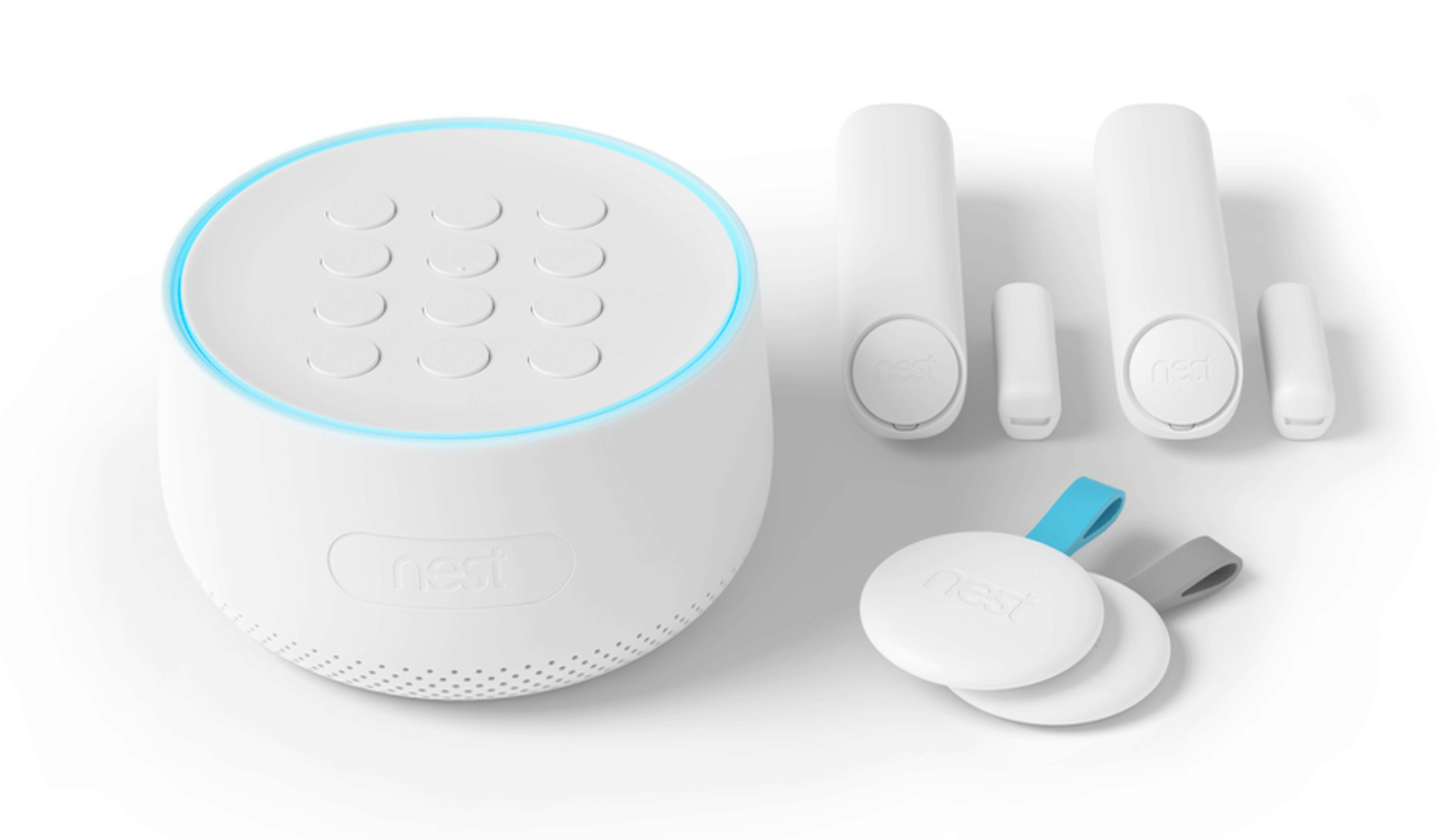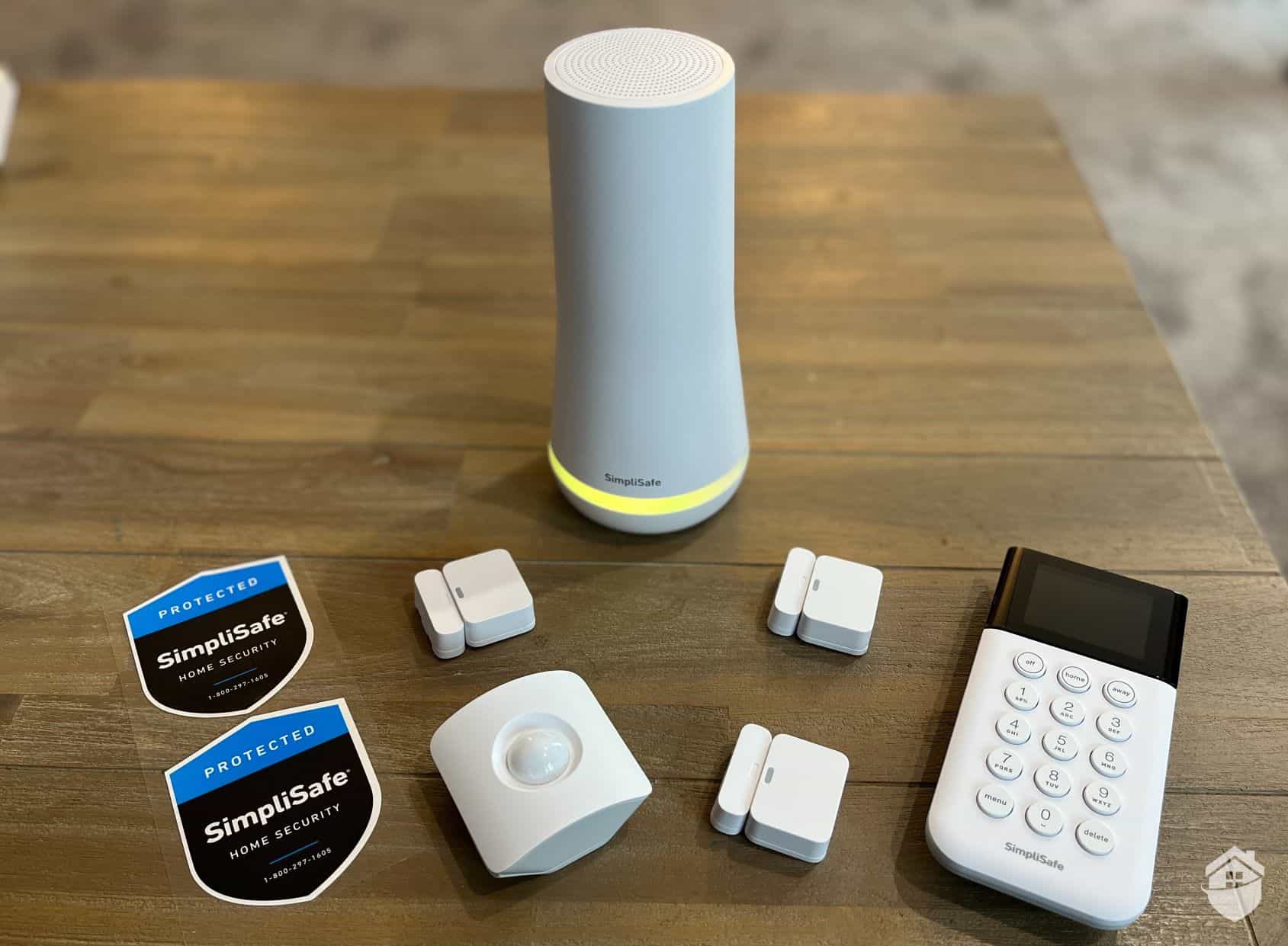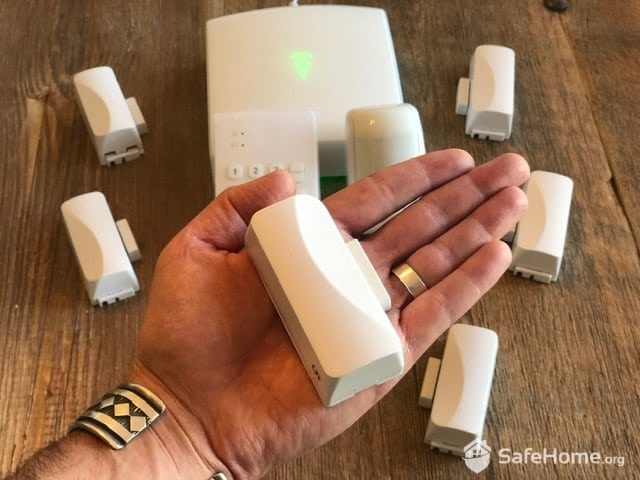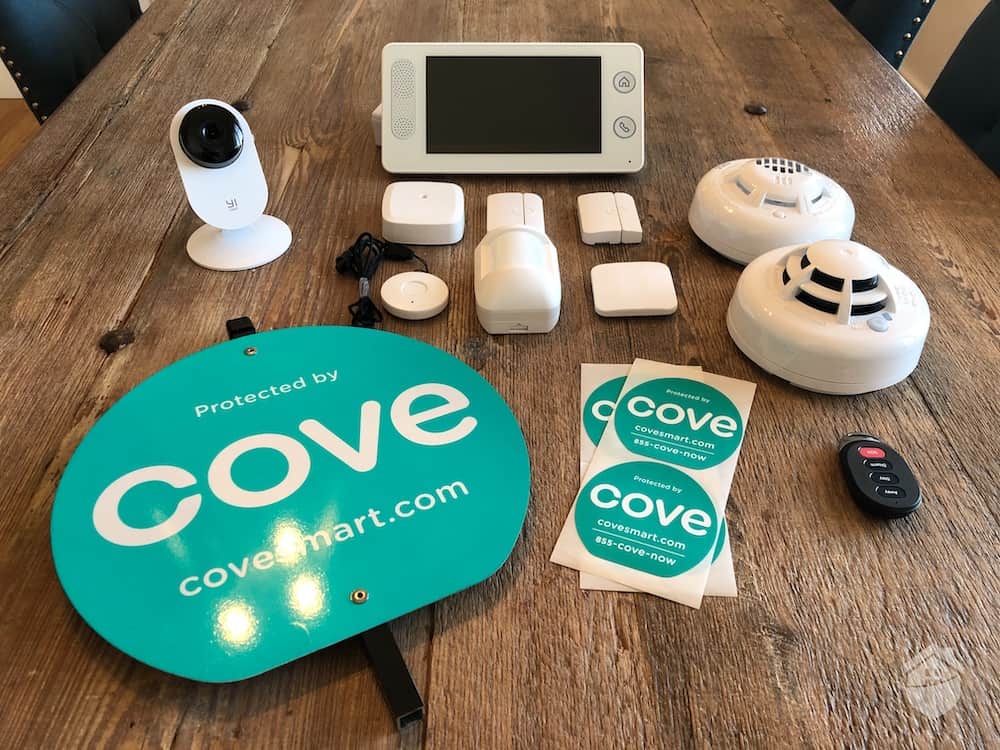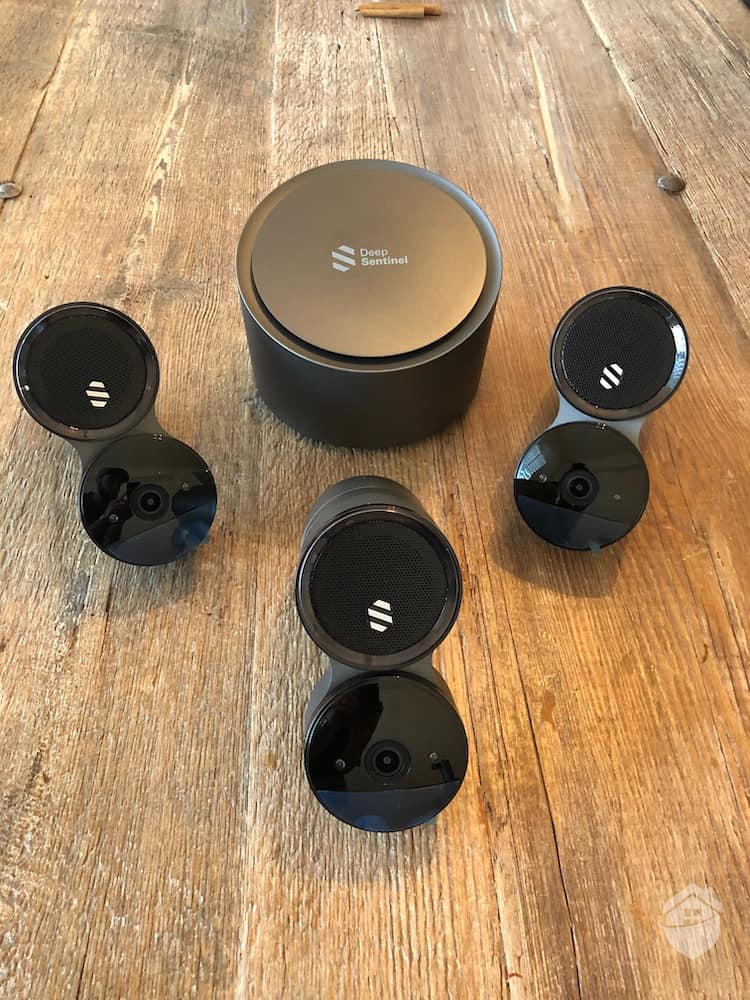Sensors, cameras, smart locks, hubs — the list goes on. There’s no shortage of quality home security equipment out there, but which components do you actually need to keep the bad guys out?
That’s the question many homeowners want to answer before they commit to a home security package, whether it’s a simple alarm and front door sensor or a deluxe ADT security system.
>> Also See: Our Experts Review ADT Home Security
In this home security guide, I’ll walk you through the basic components of effective prowler protection. I’ll also give you a few tips for ramping up your security game with an add-on or two that could make a real difference. We’ll cover:
- Hubs and alarms
- Motion sensors
- Window and door sensors
- Security cameras
- Environmental sensors (smoke, water leak, and carbon monoxide)
Pro Tip: Security systems come in two broad varieties: monitored and self-monitored. Self-monitored systems have no monthly fees, which is a definite plus. They aren’t connected to 24/7 emergency response teams either, though, which could be a problem if you ever have to deal with an intruder.
>> Go Deeper: The Best Self-Monitored Security Systems of 2023
Control Panel and Alarm
You may be able to protect your home without a camera, but you can’t keep intruders off your property without an alarm.
An alarm, for its part, can’t do anything without a security hub or control panel. Your panel is your security system’s brain. It tells your home security provider if you have an intruder and it controls all your peripherals, such as sensors and cameras. Your panel is also where you’ll set up zones and routines.
You’ll be doing most of your fine-tuning through a home security app, which is a lot more convenient than tapping commands onto a screen on the wall. But your directions will still pass through the control panel on the way to the alarm. If there’s something wrong — a faulty door sensor, say, or a low battery — you’ll see those trouble messages on the panel too.
>> We Recommend: What to Do If Your Alarm Is Going Off Randomly
FYI: Home alarms have to be at least 90 decibels and no louder than 130 decibels (which is as loud as a gun going off next to you).
Types of Home Security Systems: Pros and Cons
| Type | Pros | Cons |
|---|---|---|
| DIY | Quick, cheap, customizable installations | You may not install your equipment correctly, and you won’t have access to security professionals |
| Professionally installed | Everything will work as it should, and you’ll have access to security professionals | Expensive, time-consuming installations that require drilling and wiring |
| Self-monitored | No monthly monitoring fees | You have to call the police or fire department yourself |
| Professionally monitored | Your home security provider calls emergency services | Fees range from $10 to $50 per month |
| Wireless | Portable, and much easier and cheaper to install | More vulnerable to hacking, a limited range, and poorer video quality |
| Wired | Harder to hack, longer range, and better video quality | More difficult and expensive to install, and they’re permanent |
Motion Sensors
Motion sensors let your control panel know when someone — such as a family member, pet, or intruder — is moving through a zone or room in your home. They do it not exactly by detecting motion, but by detecting thermal heat in the form of low-level (not dangerous) infrared radiation, which all animals give off.
Once they pick up that heat energy, motion sensors transmit the message to your alarm via your panel. If your alarm is armed, you know what happens next.
Technically speaking, a few motion sensors and an alarm is a security system. If you place a sensor at every entrance, an intruder would have to be Ethan Hunt to get inside your home without triggering the alarm.
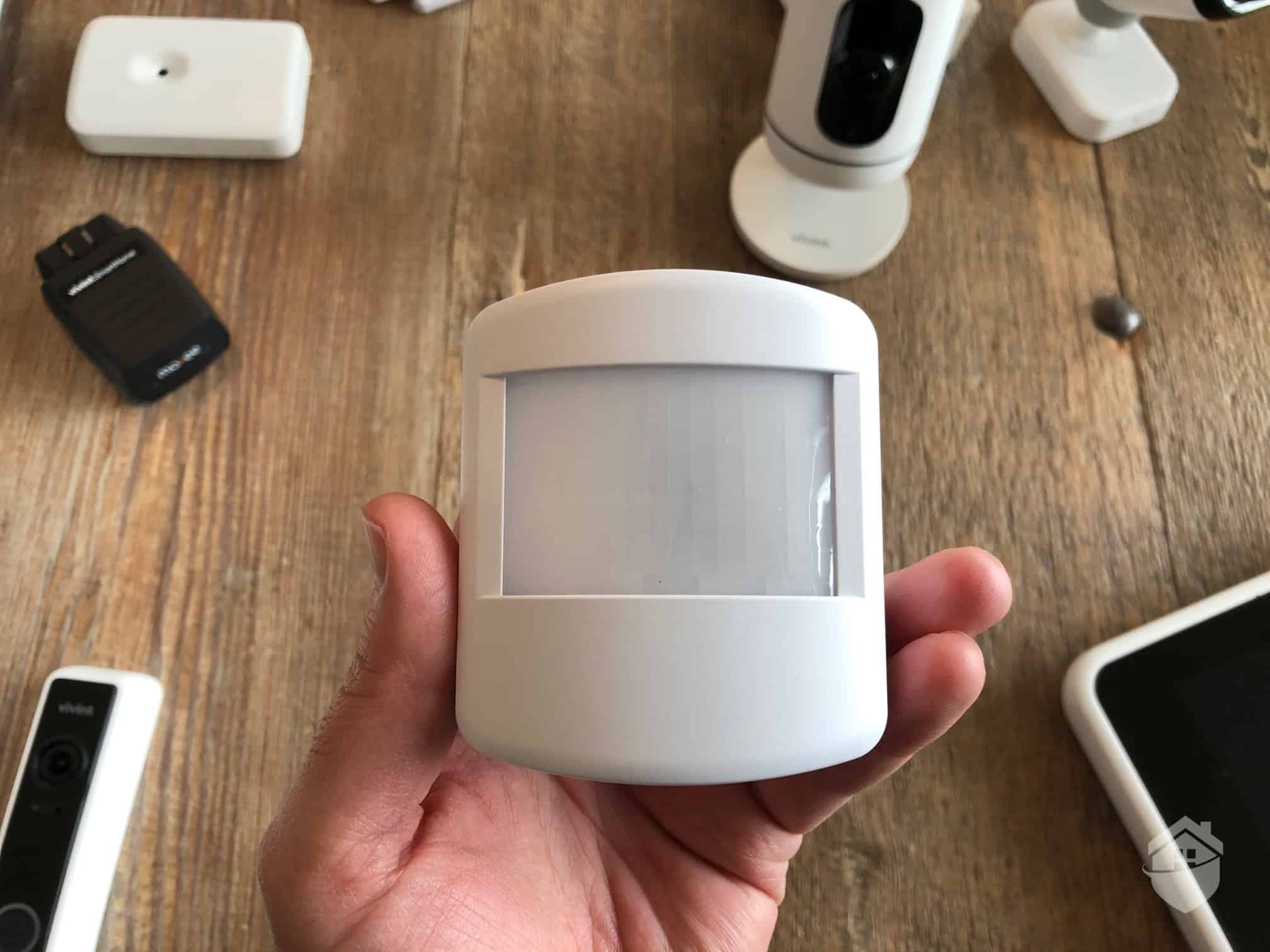
Vivint Motion Sensor
>> Read More: 10 Ways to Stop Criminals From Choosing Your Home
That’s ideally how it works, but very few of us manage to cover every square inch of our homes with sensors, and not every thief will enter through a door. They may smash or crawl through a window. Then what? Read on.
>> You Might Also Like: Meet the Real-Life Grinch Who Stole This Family’s Christmas
Did You Know? Forty-four percent of Americans have reported a run-in with a package thief.1 Here’s how to keep porch pirates off your property.
Window and Door Sensors
Window and door sensors work a little differently than the passive infrared (PIR) motion sensors discussed above. Instead, they use electromagnetic energy.
Each sensor has two magnetic pieces. One piece goes on the door frame or window casing, the other on the door or window itself. When you place the pieces at the right distance apart (about a quarter inch), electricity flows between them when shut. When opened, the current is interrupted, sending a signal to your panel to sound the alarm.
Because window and door sensors are so sensitive to changes in distance, they’re very good at catching intruders in the act. But do you need them?
>> Also Read: 7 Ways to Deter Burglars for Under $100
For entryways that aren’t directly covered by motion sensors, a door or window sensor makes sense. Back doors leading to unprotected mudrooms are particularly vulnerable. Many thieves actually prefer side and back doors for precisely that reason. Ditto for unguarded upper-story windows, which prowlers have been known to use as long as they have a roof to stand on.2
The other big advantage window and door sensors bring to the table: They stop thieves before they get inside. At around $15 (SimpliSafe) to $35 (Vivint) a pop, that’s pretty affordable prowler protection.
>> Also See: Our Experts Review SimpliSafe Home Security 2023
Extra Add-on: Glass-Break Sensors
Not all thieves have finesse. Some of them will take a sledgehammer to your window if they think it’s the easiest way in. And guess what? A window sensor can’t detect breaking glass. You need a glass sensor for that.
Glass sensors don’t detect heat or work with magnets. They have microphones that respond to the pitch of breaking glass. When they hear it, they tell your alarm.
You don’t need glass sensors on every window. Use them on particularly vulnerable entry points — side, back, or upper-story windows — for extra security.
FYI: According to our home security research, two-thirds of residential burglaries involve forced entry. The other 33 percent are “unlawful entries,” in which a thief sneaks into a house through an open door or window.
Security Cameras
Outdoor Cameras
Sensors and an alarm are all you need to send most thieves packing, but outdoor cameras are your most powerful visible deterrents. Burglars can’t see a sensor in the hall behind your front door, but they won’t miss a Lorex 4K Outdoor Camera mounted on your porch, especially when the motion-activated spotlight is drenching them in 4,000 lumens of light.
You can find plenty of quality wired and wireless camera options these days. Some of them, like the Lorex, have built-in sirens, making them essentially stand-alone security systems.
>> Don’t Miss: Our Favorite Outdoor Security Cameras This Year
Outdoor camera or indoor camera?: Tough call. If I had to choose, I’d go with outdoor. Outdoor cameras are less invasive than indoor cameras (they won’t be watching you inside), they’re better deterrents, and they serve the same purpose: to provide visual documentation of an intrusion. The only catch? They tend to be more expensive than indoor cameras.
Indoor Cameras
If outdoor cameras are the equivalent of “Do Not Enter” signs, indoor cameras are our backup eyes. Thieves may not see them — think of all that Ring and Nest Cam footage of unsuspecting burglars on YouTube — but indoor cameras definitely see thieves, and alert you instantly if they set foot inside your home.
Plenty of folks also use indoor cameras as stand-ins for outdoor cameras. They aim one at the front and back doors so they know when they have a visitor. They may miss out on some smart features outdoor cameras come with — chiefly facial recognition — but the price tag is usually a lot lighter.
Compare a Wyze Cam 3 at $34 a pop to the Arlo Pro 4, which retails for about $199. Read my complete Arlo Pro 4 Review for more on that.
Pro Tip: According to our home security research, two-thirds of residential burglaries involve forced entry. The other 33 percent are “unlawful entries,” in which a thief sneaks into a house through an open door or window.
Extra Add-on: Video Doorbells
Video doorbells, or doorbell cameras, make a strong argument for stand-alone front-door security. One, they come with two-way audio so you can talk to visitors, wanted and unwanted. Two, like outdoor cameras, you can view your feed from anywhere in high-definition video. And three, some models integrate with smart locks, making them very convenient all-in-one porch sentries. Here are the video doorbells I like this year.
>> You May Also Like: Our Top-Rated Video Doorbell Systems Compared
Did You Know? Jamie Siminoff invented what would become the Ring Doorbell in 2013, not to stop porch pirates, but to know when a package had arrived at his front door.3
Environmental Sensors
Environmental sensors, a.k.a. smoke and carbon monoxide detectors, are absolutely essential, if not required by law. The advantage of purchasing your sensors from your home security provider is a big one: integration. You can control everything through one app if everything is connected to the same hub.
Smoke Detectors
In just two or three minutes, smoke from a house fire can blanket a home, making it impossible to see, breathe, or escape.4 That’s why it’s so important to know where and how to install smoke alarms correctly.
Fortunately for anyone shopping for a home security system, all top home security brands sell them.
>> Also See: How to Make a Family Emergency Plan
Carbon Monoxide Detector
Carbon monoxide is one of the scariest gasses out there. You can’t see it, taste it, smell it, or feel it. If you have a carbon monoxide leak, you probably won’t even know — and it can wipe out a whole family overnight.
Like smoke detectors, carbon monoxide detectors are required by law in most states. If you haven’t installed yours — or you aren’t sure if you’ve done the job right — get on that ASAP. Your home security provider almost definitely carries them.
>> Required Reading: How to Install a Carbon Monoxide Detector Properly Water Leak
Water damage that catches you off guard is usually catastrophic, whether it’s from leaky pipes, malfunctioning appliances, or natural flooding. To get an idea of how catastrophic, FEMA says that just 1 inch of flood water can wreak up to $25,000 in damage.5 Yikes!
Water-leak sensors are the key to staying one step ahead of the damage. There are a few types, but they all work the same way: Once they detect unusual amounts of moisture or humidity, they sound the alarm.
FYI: Moving into a new home? Review our new home security checklist.[/citation]
Is Your Home Secure? These Are the Components You Need.
| Must-have security components | We also recommend |
|---|---|
| Control panel and alarm | Security cameras |
| Motion sensors | Glass-break sensors |
| Window and door sensors | Environmental sensors |
| Mobile alarm access (app) | Panic button |
| Video doorbell camera | Key fob for arming and disarming |
Notes: You don’t need glass-break sensors on every window in the house. Use them on vulnerable windows that aren’t protected by sensors or cameras.
Video doorbells are an alternative to outdoor cameras. If you live in a neighborhood that sees its share of package theft, consider one of the two.
The Takeaway
The scariest thing about break-ins is the loss of control. Where? What? When? Who? Without that information, you’re virtually paralyzed.
A basic home security system — motion sensors and an alarm — restores some of that control. You’ll know when someone has set foot inside your home, at least.
But plenty of folks want more of an advantage over prowlers. They want to be able to see and possibly communicate with an intruder, and they want the police at their front doors as soon as humanly possible.
If that’s you, I’d consider a more robust security system with a monitoring plan and at least a camera or two. Professional monitoring doesn’t cost more than a Spotify plan, and with today’s wireless, DIY security options, powerful cameras aren’t too expensive or difficult to install and operate.
Did You Know? Burglary has been dropping steadily since 2012, but nearly 850,000 U.S. households suffered break-ins in
FAQs
- What components do I absolutely need for my home security system?
To get started, you need motion sensors and entryway sensors connected to an alarm hub with a siren (with a mobile app). That will tell you if you have an intruder in your home and where.
- Do I need a security camera?
No, but if you’re the victim of a burglary or vandalism, you won’t be able to see what happened. Outdoor cameras are also a strong, visible deterrent against thieves.
- Should I pay for a monitored security system?
That’s really up to you. Some folks prefer not to juggle a home invasion and a 911 call at the same time. They feel safer knowing their home security provider will handle the emergency for them.
- How much does 24/7 home monitoring cost?
Plans range from about $10 per month to as high as $50.
- Are DIY home security systems reliable?
Yes, they are. DIY systems like SimpliSafe, Alder, and Frontpoint can compete with big brand names like ADT and Vivint.

